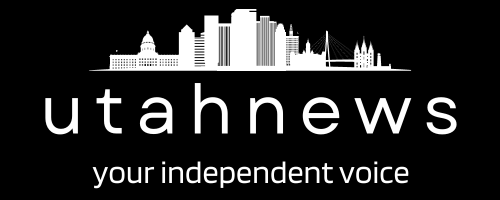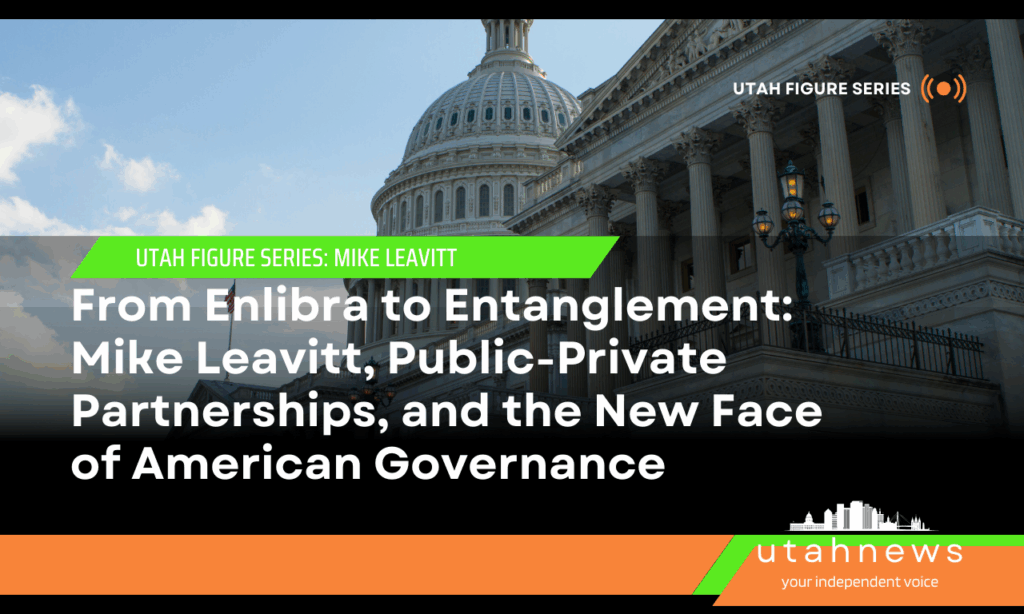Journalist: Lloyd Jensen
In the late 1990s, Utah Governor Mike Leavitt introduced a governance philosophy known as Enlibra — a “third way” approach designed to resolve environmental disputes and decentralize decision-making. With its emphasis on collaboration, market-based solutions, and stakeholder-driven processes, Enlibra quickly gained national traction. During Leavitt’s tenure as head of the Environmental Protection Agency (EPA) under President George W. Bush, Enlibra moved from a state-level initiative to a national framework, gaining formal adoption by the Western Governors’ Association and wider promotion among federal and state policymakers.
However, over time, the practical application of Enlibra evolved in unexpected ways. Particularly in Utah, the original vision has been supplanted by a system where Public-Private Partnerships (PPPs) and Authority Districts have morphed into quasi-governmental organizations, often operating with limited transparency and minimal public oversight. This article examines Enlibra’s implementation, its transformation, and the enduring impact on governance today.
The National Context: Why Enlibra Emerged
In the 1990s, environmental policy was increasingly polarized. Federal agencies often imposed top-down regulations that clashed with local realities, while states and private stakeholders expressed frustration over rigid mandates. The resulting gridlock created an urgent need for a new governance model that could balance environmental protection with economic vitality and local autonomy.
It was against this backdrop that Mike Leavitt and John Kitzhaber introduced Enlibra as a bipartisan, consensus-driven solution. Enlibra sought to replace confrontation with collaboration and regulatory rigidity with adaptive management.
Enlibra’s Foundations: Decentralization and Collaboration
Derived from Latin meaning “to move toward balance,” Enlibra rested on eight core principles:
- National Standards, Neighborhood Solutions: Higher levels of government set goals; local governments design strategies.
- Collaboration, Not Polarization: Encourage stakeholder involvement and consensus-building.
- Reward Results, Not Programs: Focus on outcomes rather than processes.
- Science for Facts, Process for Priorities: Use science to inform, not dictate, policy.
- Markets Before Mandates: Rely on market incentives before regulatory mandates.
- Change a Heart, Change a Nation: Promote stewardship through education and persuasion.
- Recognition of Benefits and Costs: Balance environmental, economic, and social impacts.
- Solutions Transcend Political Boundaries: Address problems based on ecosystems, not political lines.
When Leavitt became EPA Administrator in 2003, he expanded Enlibra’s principles within the federal government. Rather than a Washington-centric approach, the EPA under Leavitt emphasized partnership with states, tribes, businesses, and nonprofits. Early outcomes suggested that empowering localities and private stakeholders could yield practical, site-specific solutions.
Public-Private Partnerships: From Contractual Collaboration to Institutional Permanence
Public-Private Partnerships (PPPs) were a natural extension of Enlibra’s philosophy. Properly structured, PPPs are intended to be temporary, transparent, and accountable, facilitating specific projects without creating enduring entanglements.
Initially, PPPs allowed governments to harness private sector expertise and efficiency for public benefit. Successful examples included contracts to build roads, upgrade water systems, and develop renewable energy projects — all with clear timelines and deliverables.
However, in Utah, these partnerships gradually evolved into permanent, quasi-governmental entities, raising concerns about transparency and public accountability.
For example, the rise of Special Districts, particularly Public Infrastructure Districts (PIDs), illustrates this transformation. These districts:
- Often operate with limited public scrutiny.
- Possess authority to levy taxes and incur debt without direct voter approval.
- Frequently align with private development interests rather than broader community needs.
One notable case is the Traverse Ridge Special Service District in Draper, Utah, where homeowners faced unexpected and sharply rising property assessments to fund infrastructure projects managed by a district board dominated by development interests. Residents had little recourse to challenge financial decisions made without their direct consent.
Another example is the Daybreak Community Development in South Jordan, where a special district issued millions in bonds to finance new infrastructure for a master-planned community. While marketed as a public good, the district primarily benefited a single private developer, transferring long-term tax burdens onto future homeowners who had no voice in the original creation of the district.
Instead of being temporary collaborations, many special districts have become perpetual bureaucracies. They are managed by appointed boards rather than elected officials, making them less accountable to the public. In many cases, citizens first encounter these districts only when facing unexpected tax hikes or property assessments tied to infrastructure they had no voice in approving.
Rather than fulfilling Enlibra’s goal of enhancing local control, these entities sometimes consolidate power among a narrow group of stakeholders, sidelining the broader electorate.
The Shift to Stakeholder Governance
Stakeholder-driven governance was envisioned as a means to foster inclusive decision-making. Ideally, it would give all affected parties a voice in shaping policies and projects.
However, Utah’s experience demonstrates that stakeholder models can, without proper safeguards, centralize authority among well-connected private and nonprofit actors. Traditional public institutions, accountable through elections, are increasingly circumvented by governing boards and collaborative bodies that operate outside normal democratic channels.
For instance, the Point of the Mountain Development Commission, a coalition of government appointees, business leaders, and university representatives, collaboratively steered major redevelopment efforts with limited direct public input, despite massive taxpayer implications.
Similarly, the creation of the Utah Inland Port Authority (UIPA) involved a stakeholder governance model that brought together industry figures and government officials, but sidelined local communities most affected by the project.
While some stakeholder processes genuinely seek consensus, many are dominated by powerful interest groups. Developers, large nonprofits, and politically connected businesses often have disproportionate influence compared to average citizens.
The practical consequence has been the gradual erosion of direct democratic control, with citizens increasingly subject to policies and tax obligations imposed by entities they neither elect nor oversee.
Authority Districts: A Growing Concern
Building on the stakeholder governance model, Authority Districts in Utah represent an even deeper shift away from traditional democratic oversight. These entities, often called Independent Entities or Authority Districts, are created directly by the legislature and granted significant regulatory and taxing powers, functioning almost as self-contained government corporations.
Examples include the Utah Inland Port Authority (UIPA) and the Point of the Mountain State Land Authority. These organizations manage large-scale development projects, control valuable public lands, and make decisions impacting local communities — all with limited direct accountability to voters. Board members are typically appointed by government executives or selected from among industry stakeholders, not elected by the general public.
Critics argue that Authority Districts, while designed to streamline major infrastructure and economic initiatives, have further concentrated power among politically connected interests, sidelining local residents and municipalities. The creation of these entities illustrates how collaborative, stakeholder-driven governance, when left unchecked, can evolve into governance structures almost entirely insulated from public control.
Special Districts: A Case Study in Mission Drift
A 2025 report on special districts highlights how far some implementations have drifted from Enlibra’s original ideals.
Utah has seen a rapid increase in the number of special districts, with over 800 currently in operation. Many of these districts possess sweeping powers:
- Taxation Authority: Ability to impose taxes without a general vote.
- Eminent Domain: Power to seize property for infrastructure development.
- Debt Issuance: Authorization to issue long-term municipal bonds.
Special districts, particularly Public Infrastructure Districts (PIDs), often serve as financial vehicles for private development projects. They can leverage public credit ratings and taxpayer dollars to subsidize new residential and commercial construction, frequently benefiting developers at public expense.
Legislation passed during Utah’s 2023 legislative session, specifically HB22 and HB77, expanded the powers of special districts by reclassifying local districts and modifying governance structures, thereby reducing municipal oversight and streamlining the creation process for new districts.
While initially intended to enable efficient, localized solutions, special districts now often function as semi-private governance structures operating beyond the reach of direct democratic accountability.
The Path Forward
The evolution of Enlibra’s principles highlights a critical lesson: governance reforms must be tethered to enduring commitments to transparency, accountability, and public consent.
Without strong safeguards, collaborative governance models risk enabling elite consolidation of power rather than genuine community empowerment. Temporary partnerships can ossify into permanent bureaucracies. Local control can morph into stakeholder oligarchy.
Future reforms should prioritize:
- Time-limited PPPs with automatic sunset provisions.
- Mandatory public disclosure of all financial dealings by special districts.
- Requirement of public votes before granting taxing or borrowing authority.
- Clear separation between public authority and private interest.
Conclusion: From Vision to Vigilance
Mike Leavitt’s Enlibra initiative may have been a sincere, forward-thinking attempt to address entrenched problems in American governance. Its emphasis on balance, collaboration, and local empowerment remains relevant today.
However, the Utah experience serves as a cautionary tale. Even visionary reforms can be co-opted over time, especially if citizens are not vigilant in defending transparency and accountability.
The transformation of Public-Private Partnerships into permanent quasi-governmental entities, the unchecked proliferation of special districts, and the rise of independent Authority Districts all highlight the need for renewed commitment to foundational principles.
In an era where governance increasingly blends public, private, and nonprofit actors, safeguarding the voice and rights of ordinary citizens is more important than ever. Reforms must not only foster innovation — they must preserve democracy (ours is a Constitutional Republic.)
Otherwise, the very flexibility and collaboration once seen as solutions risk becoming new forms of entanglement, distancing government from the people it was meant to serve.
Works Cited
- Western Governors’ Association. “Enlibra: The Western Governors’ Environmental Framework.” 1998.
- Environmental Protection Agency. “Innovation Action Council Charter.” 2004.
- Utah State Legislature. “HB22 (2023) – Local District Amendments.” 2023 Legislative Session.
- Utah State Legislature. “HB77 (2023) – Improvement District Amendments.” 2023 Legislative Session.
- Utah Government Report. “Special Districts and More: Understanding the Impact of HB22 and HB77.” 2023.
- Utah Association of Special Districts (UASD). “2023 Legislative Update and Overview.” 2023. https://uasd.org/uploads/files/18167/UASD-2023-Legislative-Update-and-overview-4132023.pdf
- Deseret News. “Utah Inland Port Authority: Balancing Development and Accountability.” 2023.
- Point of the Mountain State Land Authority. “Development Framework and Governance Overview.” 2023.
- United Nations. “Sustainable Development Goals (SDGs).” 2015. https://sdgs.un.org/goals
Additional Supporting Resources
- National Association of Counties (NACo). “Understanding Special Districts: Governance and Accountability Issues.” 2021.
- Brookings Institution. “Public-Private Partnerships: Promise and Peril.” 2016.
- Western Governors’ Association. “Collaborative Governance: Principles and Practice.” 2010.
- Utah State Auditor’s Office. “Performance Audit of Special Service Districts.” 2018.
- Libertas Institute. “Public Infrastructure Districts in Utah: Hidden Taxes and Private Benefits.” 2022

